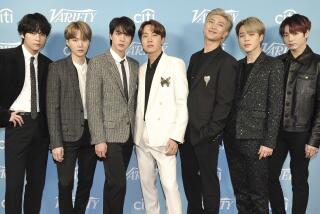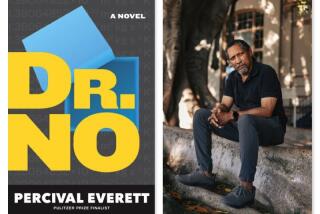‘Jumanji’ Author Getting Aboard Hollywood Express : Movies: Chris Van Allsburg says the film version of his book is like a Christmas gift. It’s just not the one he was expecting.
Among the phrases Chris Van Allsburg picked up in his total-immersion introduction to Hollywood was the expression “laying pipe.” For most people the term might suggest sewer construction, but Van Allsburg soon learned that laying pipe is actually a crucial element of story development--meaning that the weirdness a character displays in Act 1 will explain the plot twists in Act 3.
Van Allsburg now uses such jargon so convincingly that it’s hard to imagine that in the 3 1/2-year course of “repurposing” his book “Jumanji” into TriStar’s big 1995 holiday release, opening Friday, the artist and author never spent a single day on the West Coast. “I never went,” he said.
Instead, Hollywood came to him. Two of his 14 titles have won Caldecott Awards, the highest prize for illustrated children’s books. “Jumanji,” published in 1981 by Houghton Mifflin, also earned Van Allsburg a National Book Award for book illustration. Between his accolades and a generation of filmmakers who were regaling their own children with “Jumanji,” “The Polar Express,” “Two Bad Ants” and other Van Allsburg works, the bear-shaped, bearded author entertained a stream of offers. Most, he recalled, were longer on enthusiasm than on capital.
Then his editor suggested that he drive up to Boston for a meeting with some folks from Sony. There to meet him was Peter Guber himself, then emperor of all of Sonyland. Van Allsburg flattered himself for about 30 seconds before realizing that Guber’s sole purpose in visiting New England was not simply to option “Jumanji.”
“My recollection is that his parents were selling his boyhood home in Boston,” Van Allsburg said, “so he was there anyway.”
But the fact that the studio head was there at all persuaded Houghton Mifflin, and Van Allsburg, that the tale of an ancient, magical board game that goes awry had finally found a film home. Again, for somewhat less than one minute, Van Allsburg mused about the implications of having Robin Williams star in the movie based on his book.
“I’ve heard stories about authors filled with this kind of Lotto-winner hubris,” Van Allsburg said. “I’m a Dutch boy from the Midwest. We don’t have hubris.”
*
Growing up in Grand Rapids, Mich., in the 1950s, what Van Allsburg had was the kind of idealized childhood that Americans now dream of. Parents were married, to each other, and tended to have two or three kids. The houses were cozy and comfortable. Young Chris caught tadpoles in the pond down the street. Van Allsburg’s family ran a dairy business, processing raw milk into cottage cheese and ice cream. He has said that as a child, he was more comfortable holding a football than a crayon. But when he enrolled in a freshman drawing class at the University of Michigan, he found his calling. The dairyman’s son majored in fine arts, then headed to the Rhode Island School of Design for an advanced degree in sculpture.
Upon graduation, Van Allsburg was not exactly flooded with employment opportunities. “They don’t send people from large corporations to hire people to make sculptures,” he observed. It was his wife, Lisa, then working as a producer for a local television show, who urged him to expand his drawings into picture books. Author-artist David Macaulay--whose books “Cathedral,” “Castle” and others had been made into television series--introduced Van Allsburg to his own editor at Houghton Mifflin, Walter Lorraine. In 1979, Lorraine published Van Allsburg’s first book, “The Garden of Abdul Gasazi,” about a gardener who turns dogs into ducks.
*
Stranger than fiction, but then again it is fiction--unlike the storybook tale of Van Allsburg’s subsequent success. Here in their big, brick home with its sturdy Mission furniture and its graceful William Morris wallpaper, the Van Allsburgs care for their daughters Sophia, 4 1/2, and Anna, 8 months, as well as an occasionally incontinent hamster. In his third-floor studio, Van Allsburg, 46, draws and makes sculpture that is sold through a New York gallery.
All along, he said, “I was just drawing pictures and writing stories for fun. I thought of my job as a sculptor. The drawing and writing was sort of a hobby.”
While writers who can also draw, or vice versa, are not uncommon in the realm of children’s literature, they are not abundant, either. Van Allsburg thinks of himself as an artist above all. He admits that “the theory of isolation of certain tasks in certain hemispheres of the brain suggests I shouldn’t even be able to speak, never mind write.”
But he did have a go-round at one of the numerous drafts of the “Jumanji” screenplay. Writing longhand, on yellow pads, he discovered he enjoyed the challenge of transforming a 32-page picture book into a 100-minute movie.
“I didn’t find it terribly intimidating,” Van Allsburg said. “In some ways, it took a lot less time to tell it in words than in pictures.”
While harboring doubts “as an artist about the questionable value of collaboration, especially sequential collaboration,” Van Allsburg said he is nonetheless pleased with the film version of “Jumanji.”
“The film is faithful in reproducing the chaos level that comes with having a jungle animal in the house. It’s a good movie,” he said, although perhaps not the story he created in the first place. “But my impulse as an artist is to be drawn to the idiosyncratic and the peculiar. And the fact is, they don’t make $78-million idiosyncratic movies.”
*
In his own stab at the screenplay, Van Allsburg said he was “sort of trying to imbue the story with a quality of mystery and surrealism”--qualities that may not have survived as strongly as he wished. With diplomacy, he added, “I do not mean to suggest that this film is burdened by extraordinarily commercial ideas. But in some ways, it has a different story structure than what I wrote.”
He noted also that the time involved in awaiting the movie may have colored his expectations. “It’s a little like waiting for Santa Claus,” Van Allsburg said. “You don’t know if he’s going to bring you an electric train or a piece of coal.” In “Jumanji,” he got an electric train--”just not the train I expected.”
Still, Van Allsburg rejects the stock cynicism about writers who sell their wares in Lotusland. “There’s definitely a value in being literate,” he said. “But I don’t see film-viewing as being an obstacle to acquiring literacy. . . . “ With 3-million-plus copies in print, Van Allsburg’s “Polar Express” seems the next likely candidate for film adaptation. His “Jumanji” experience has made that prospect look rather appealing.
Imagine that train, Van Allsburg said, as a “moving, two-dimensional reality.” Just thinking about it, his eyes turned bright and sparkled.
More to Read
Sign up for our Book Club newsletter
Get the latest news, events and more from the Los Angeles Times Book Club, and help us get L.A. reading and talking.
You may occasionally receive promotional content from the Los Angeles Times.






